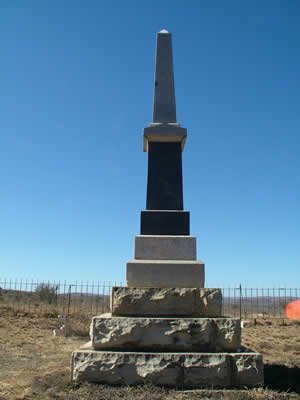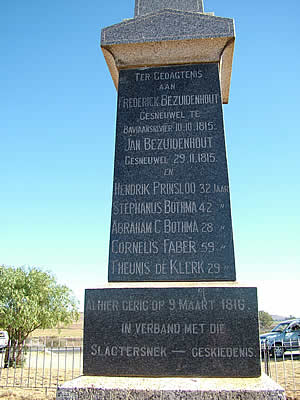Slachter's Nek Exhibition at Somerset East - Somerset East
- Somerset East
Last Updated: November 2016
Contact Somerset East Tourism
- 042 243 2079
- bluecranetourism@gmail.com
Location
- Longitude: 25.585021
- Latitude: -32.712556
- Map
About Slachter's Nek Exhibition at Somerset East
In 1815, a farmer from the eastern border of the Cape Colony, Frederik Bezuidenhout, was summoned to appear before a magistrate's court after repeated allegations of his mistreating one of his Khoi labourers. Bezuidenhout resisted arrest and fled to a cave near his home where he defended himself against the soldiers sent to capture him. When he refused to surrender he was shot dead by one of the soldiers.
One of Bezuidenhout's brothers, Hans Bezuidenhout, swore revenge. Together with a neighbour Hendrik Prinsloo, Hans Bezuidenhout organised an uprising against the British colonial power, believed by them to be hostile towards the Afrikaner farmers. On 18th November 1815, a commando of rebels met an armed force from Landdrost (magistrate) Jacob Cuyler, the military commander on the eastern frontier, at Slachter's Nek. Negotiations failed and the majority of the rebels left without any shots being fired. Twenty rebels surrendered, followed by several more over the following days. However, some of the leaders, among whom was Hans Bezuidenhout, refused to turn themselves over to the British authorities. On 29th November 1815, they were attacked by colonial troops. Everybody but Bezuidenhout surrendered and, like his brother, Hans died while resisting arrest.
The rebels were finally charged at Uitenhage. Some were cleared, others imprisoned or banished. Six were sentenced to death but one of these was pardoned by the Governor, Lord Charles Somerset. On 9th March 1816 the remaining five were hanged in public at Van Aardtspos. Four of the nooses broke during the procedure as the hangman who came to perform the execution had not realised there were five to be hung, and old ropes had to be used. The four whose ropes broke, as well as the public, pleaded for their lives but Culyer ordered that they be hanged a second time and they were hung one by one. The names of the five who were hanged were Hendrik Prinsloo, Stephanus Bothma, Abraham Bothma, Cornelius Faber and Theunis de Klerk.
Although many of the frontier boere did not support or agree with the rebellion, some Voortrekkers have claimed that it was one of the reasons for the Great Trek.
Colonel Jacob Glen Cuyler was an American by birth who had remained loyal to Britain during the rebellion of the American colonies. He had first hand experience of the harshness meted out to loyalists by the rebels and had consequently a strong aversion for rebels, unfortunately for the Slachter's Nek rebels.
On 9th March 1916, exactly 100 years after the execution, a monument was unveiled on the spot where the hanging took place, on the N10 south of Cookhouse.
 |
 |
The Somerset East Museum houses an exhibition staged around the original beam on which the five Slachter's Nek rebels were hung in 1816 by representatives of Lord Charles Somerset, Governor of the Cape at the time.
After 1806 the British authorities were determined to stamp out the lawlessness in the Eastern Districts of the Cape. Various strategies were implemented in order to bring the pioneer frontier farmers within the framework of regular government and the rule of law. While some accepted the new changes, others in the more isolated and inhospitable areas remained suspicious of British motives and intentions....So begins the story of the 1815 Eastern Cape Rebellion, otherwise known as SLACHTER'S NEK.
Although there were a number of other revolts in the same district, none of these left a more lasting and powerful impression in the minds of the generations still to come - implications which ultimately played a vital role in the shaping and development of South Africa as a whole.
The exhibition strives to portray a glimpse into the lives of the ordinary people - the frontier Boers, Cape Regiment soldiers, Chief Ngqika and the British authorities - but it goes further. It explains how the Slachter's Nek executions moved people like Paul Kruger, DF Malan, CJ Langenhoven and Andre P Brink to contribute to the debate surrounding the aftermath of the event - in order to keep the memories of those involved alive.
Included in the exhibition are:
Timelines (1815) - Battle of Waterloo; Somerset Farm; Battle of New Orleans; the Year without a Summer, etc.
Relevant contemporary issues such as the role of Nationalism in the development and expansion of nation states and he role of the Slachter's Nek beam in the shaping of Afrikaner Nationalism•History and debates around the topic of Capital Punishment
This ensures that the Slachter's Nek exhibition remains relevant to current educational needs.
The Slachter's Nek monument is to be found on the N10 between Cookhouse and Golden Valley, at the site where the incident took place.
J.C. van der Walt's book, Rebels of Slagtersnek 1815, is available at the Somerset East Museum, and at the Walter Battiss Art Museum.

